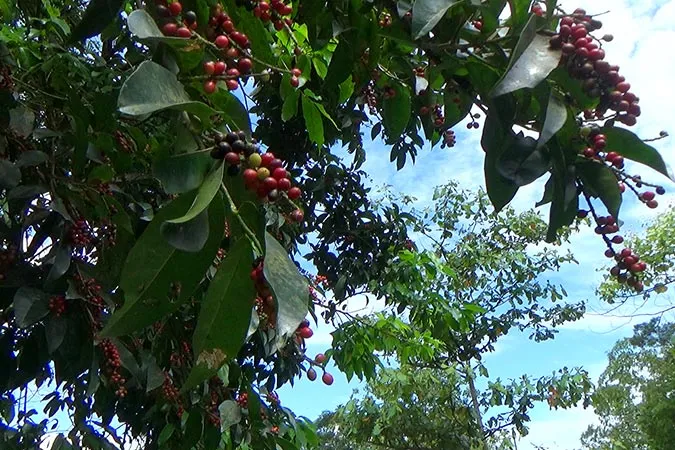Bignay or buni (Antidesma bunius) is a plant species in Phyllanthaceae, deciduous trees, up to 30 m tall, straight stems and 20-25 cm in diameter, many branches and shade, small fruits arranged in a long stalk, eaten raw or deep cooking or fermented into grapes.
A. bunius has leaves with 1 cm long stalks, alternating, oblong-lanceolate, 19-25 cm long, 4-10 cm wide, rounded base, sharp or blunt tip, flat margins, dark green and shiny upper surface, bright lower surface, a main bone runs in the middle and appears on the underside of the leaf.
Male and female flowers are located in different trees and arranged in the form of panicles 6-20 cm long. Female flower size is larger than male flowers. Terminal or axillary and narrowly spicate or racemose.
Male flowers sit, cupular petals consisting of 3-4 short rounded petals, 3-4 stamens and reddish in color. Female flowers have a stalk, bell-shaped petals, 3-4 lobes measuring 1x2 mm, ovary ovoid, 3-4 pistil heads with small discs.
Wet and drupe fruit, round or ovoid and 8-10 mm in diameter. First it is bright green with a sour taste, then red and bluish black with a sweet taste. Fruit arranged in bunches with a diameter of 3 cm. Elongated ovate seeds, 6-8 mm long and 4.5-5.5 mm wide.
Bignay grows wild in the tropics at an altitude of 0-1000 m, tolerant of drought and damp. Fresh edible fruit, jam and jelly ingredients, extracts for refreshing drinks and produce special wine. Sometimes used to mix cold drinks. Young fruit and young leaves are used as a substitute for vinegar.
Young leaves to give aroma to fish or boiled meat, fresh vegetables and cooked with rice. Bark and leaves contain alkaloids which have medicinal properties, but are also poisonous. The wood is reddish, hard and has a pretty good quality.
Kingdom: Plantae
Phylum: Tracheophyta
Subphylum: Angiospermae
Class: Magnoliopsida
Order: Malpighiales
Family: Phyllanthaceae
Genus: Antidesma
Species: Antidesma bunius
A. bunius has leaves with 1 cm long stalks, alternating, oblong-lanceolate, 19-25 cm long, 4-10 cm wide, rounded base, sharp or blunt tip, flat margins, dark green and shiny upper surface, bright lower surface, a main bone runs in the middle and appears on the underside of the leaf.
Male and female flowers are located in different trees and arranged in the form of panicles 6-20 cm long. Female flower size is larger than male flowers. Terminal or axillary and narrowly spicate or racemose.
Male flowers sit, cupular petals consisting of 3-4 short rounded petals, 3-4 stamens and reddish in color. Female flowers have a stalk, bell-shaped petals, 3-4 lobes measuring 1x2 mm, ovary ovoid, 3-4 pistil heads with small discs.
Wet and drupe fruit, round or ovoid and 8-10 mm in diameter. First it is bright green with a sour taste, then red and bluish black with a sweet taste. Fruit arranged in bunches with a diameter of 3 cm. Elongated ovate seeds, 6-8 mm long and 4.5-5.5 mm wide.
Bignay grows wild in the tropics at an altitude of 0-1000 m, tolerant of drought and damp. Fresh edible fruit, jam and jelly ingredients, extracts for refreshing drinks and produce special wine. Sometimes used to mix cold drinks. Young fruit and young leaves are used as a substitute for vinegar.
Young leaves to give aroma to fish or boiled meat, fresh vegetables and cooked with rice. Bark and leaves contain alkaloids which have medicinal properties, but are also poisonous. The wood is reddish, hard and has a pretty good quality.
Kingdom: Plantae
Phylum: Tracheophyta
Subphylum: Angiospermae
Class: Magnoliopsida
Order: Malpighiales
Family: Phyllanthaceae
Genus: Antidesma
Species: Antidesma bunius
